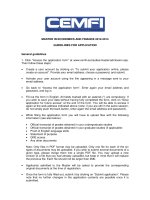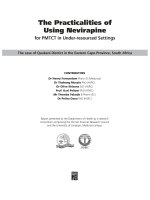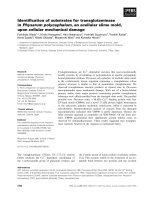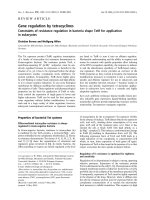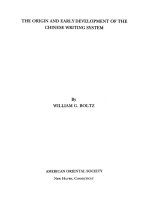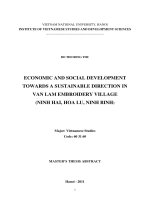nvestigating the influences of tidal inundation and surface elevation on the establishment and early development of mangroves for application in understanding mangrove rehabilitation techniques 1 4
Bạn đang xem bản rút gọn của tài liệu. Xem và tải ngay bản đầy đủ của tài liệu tại đây (954.96 KB, 23 trang )
Chapter 3 – Surface elevation is an important factor in
achieving mangrove rehabilitation success
3.1 Introduction
The number of mangrove rehabilitation programmes implemented world-wide is
extensive, the majority of which have been executed by governments and local
stakeholders to restore forest cover and habitat functionality of degraded mangrove
systems (Katon et al., 2000; Barbier, 2006). This commonly takes the form of planting
and replanting (when previous attempts have failed) of mangrove propagules and/or
seedlings, with low survival rates (Samson & Rollon, 2008). Yet, rehabilitation
programmes can be successful if rehabilitation methods involve matching
environmental conditions to the autecology of mangrove species.
This can be achieved if rehabilitation methods prioritise and optimise structural
manipulation to remove barriers (e.g. dike walls) and allow for the regeneration of
mangroves via natural recruitment and establishment. This encompasses hydrological
and substrate regrading for re-establishment of appropriate hydrologic regime and
elevation ranges (Stanley & Lewis, 2011) since hydrology and surface elevations are
major leverage points influencing mangrove establishment, survival and development
because of its control on inundation regimes. Notably, inundation is one of the primary
factors in determining the establishment, survival and growth of mangroves because of
its influence on secondary factors such as oxygen availability, salinity and pH (Krauss
et al., 2008).
Hence, knowledge of appropriate surface elevation and its influence on inundation
frequency, period and depth may be one of the more important factors that determine
24
the overall success of mangrove rehabilitation projects (Lewis, 2005; Gilman &
Ellison, 2007). Through executing a rehabilitation project, this study investigated the
contributions of two aspects of hydrologic restoration to the successful colonisation of
mangrove vegetation in rehabilitated sites. The study focused on (i) restoring a natural
tidal inundation regime via strategic breaching and (ii) regrading selected areas to
suitable surface elevations.
3.2 Materials and Methods
3.2.1 Study area
The Western coastline in South Sulawesi Province, Indonesia, experiences a
monsoonal climate. The northwest monsoon (December – March) is characterised by
high precipitation and strong winds while the southeast monsoon (June – September)
brings negligible rainfall (Visser et al., 2004). This coastline experiences a tidal range
of 1.6 m with a mean tidal range of 0.95 m, with Mean High Water Spring at 1.33 m
Chart Datum.
This study was conducted in three locations near the fishing villages of Kurri Caddi
and Kurri Lompo (5° 01' 57" S, 119° 28' 04" E, Figure 3.1). The main study site
consists of 29 disused aquaculture ponds, covering 21.5 ha. Before rehabilitation, the
ponds were used for semi-intensive farming of brackish water shrimp and milkfish
polyculture. These ponds were created in the early 1980s and originally operated by a
Korean venture. They were then bought and managed by the University of
Muhammadiyah, Makassar (UNISMUH). In the past, neighbouring communities had
no access or use rights in the ponds. However, after an agreement was reached
between Mangrove Action Project – Indonesia (MAP-I) (now Blue Forests Indonesia),
an NGO, and UNISMUH, MAP-I was allowed to conduct rehabilitation works in the
25
aquaculture ponds. The community now holds rights to access non-timber resources in
some ponds and collaborate with MAP-I in participatory action research involving
mangroves, aquaculture ponds and their own rice-fields. Interested members of the
community are also involved in a multi-stakeholder working group involving
academic, governmental and NGO partners, which serve as to manage and advise
mangrove rehabilitation.
Riverine/lower estuarine mangroves surround these aquaculture ponds. Two reference
forests, comprised solely of coastal and riverine greenbelts, located at a distance of 2.3
km and 0.05 km from the aquaculture ponds and approximately 200 and 50 m wide
respectively, were surveyed (Figure 3.1b). Although only a subset of natural mangrove
surface gradients and floral species can be found at the reference forests, these sites
nonetheless present the best reference as more than 90% of mangroves in Maros and
neighbouring Pangkep District have been converted into aquaculture.
26
Figure 3.1: (a) Regional setting of Makassar (black box), South Sulawesi, Indonesia; (b)
former aquaculture ponds at Kuri Caddi and reference forests at both Kuri Caddi and Kuri
Lompo; and (c) broken lines delineate the disused aquaculture ponds in Kuri Caddi, extracted
from Google Earth (dated February 2014).
3.2.2 Field data collection
Pre-rehabilitation mapping of abandoned aquaculture ponds – In September 2013, a
Trimble Real Time Kinematic GPS (RTK-GPS) was used to establish nine elevation
benchmarks throughout the site in the WGS84 coordinate system. From these
benchmarks, a topographic survey of the former aquaculture ponds was conducted
using a Total Station (Topcon GTS-235N; 1 mm relative accuracy), with each
27
sampling point resulted from the mean of three readings taken. As the topography of
the ponds was not highly complex, surface elevation measurements were sampled
along both dike walls and in the ponds at (approximately) every 3 metres. Sampling
point density was increased when abrupt changes in surface elevation were observed
(i.e. sudden drop between the dike walls into aquaculture pond).
Rehabilitation of aquaculture ponds – In November 2013, rehabilitation works were
implemented in selected areas in the ponds through the use of an excavator and
community labour with hand tools. Dike walls were strategically breached, based on
the elevation gradients observed from the previous topographic mapping exercise, in
order to restore hydrological flows. Some were regraded entirely to produce substrate
at an appropriate surface elevation for mangroves, relative to sea level (Figure 3.2). A
pile of broken branches was also deployed in one pond, designed to trap floating
propagules. Across the 29 aquaculture ponds, a total of 16 breaches were made in the
dike walls. Since seed banks are generally absent in mangroves (Harun-or-Rashid et
al., 2009), hand broadcasting of locally-collected propagules was conducted at high
tide to overcome propagule availability as a limiting factor. Approximately 206250
Aegiceras corniculatum (55 kg; 3750 propagules kg-1), 1500 Avicennia sp. (10 kg; 150
propagules kg-1), 2380 Bruguiera gymnorrhiza (70 kg; 34 propagules kg-1) and 8600
Ceriops tagal (47 kg; 183 propagules kg-1) were broadcasted in December 2013.
Rhizophora spp., Sonneratia spp. and B. cylindrica propagules were also broadcasted,
but in unknown quantities. To facilitate seedling establishment, the ponds were
subsequently left untouched.
28
Figure 3.2: (a) Dike walls that have undergone strategic breaching, and (b) regrading of
selective dike walls to produce substrate at lower surface elevations (foreground). Red arrows
point to existing dike walls.
3.2.3 Post-rehabilitation vegetation survey in aquaculture ponds and reference
mangrove forests
A second topographic survey using a Total Station anchored to the existing
benchmarks was conducted in June 2014. First, an elevation survey was conducted to
measure changes in surface elevation of regraded areas. Then, a second survey was
conducted to measure the surface elevation at which mangrove vegetation had
established inside the newly restored site. Vegetation was identified to species level
29
and categorised into three size classes – seedling (< 0.7 m in height), sapling (> 0.7 m
in height but < 7 cm Diameter-Breast-Height; DBH) and tree (≥ 7 cm DBH).
Separately, this survey was repeated in the reference forests (i.e. the two natural
mangrove forests near Kuri Caddi and Kuri Lompo) in order to produce the elevation
envelope (inter-quartile range) of the natural mangrove elevation range for different
species.
3.2.4 Genera-specific surface elevation envelopes and prediction maps
ArcGIS was used to generate a Digital Elevation Map (DEM) of the ponds using the
Linear interpolation algorithm with the chosen grid cell size (resolution) of 1.
The statistical computing software R 3.1.2 (R development core team, 2014) was used
to define species-specific elevation envelopes. This was computed separately for trees
and seedlings, and if they were established in reference forests or aquaculture ponds.
Thereafter, species-specific elevation envelopes for trees in reference forests were
checked for normality and equality of variances before conducting a t-test. Given that
the species-specific elevation envelope between two species (per genus) were
statistically similar (p-value < 0.05), they were combined to give a genera-specific
elevation envelope for genera Avicennia, Rhizophora and Sonneratia.
The Raster Calculator in ArcGIS was used to delineate areas in the aquaculture ponds
exhibiting the exact elevation range in each genera-specific elevation envelope data.
This created a prediction map of aquaculture ponds of predicted future mangrove
growth for each of the three genera – Avicennia, Rhizophora and Sonneratia.
30
3.3 Results
3.3.1 Vegetation established in aquaculture ponds and reference mangrove forests
A total of 471 seedlings and saplings and 180 trees were surveyed in aquaculture
ponds compared to the 213 seedlings and saplings and 140 trees in reference forests
(Table 3.1). In the ponds, Rhizophora was the most abundant seedling/sapling genera
(n = 254) with Avicennia as the second most abundant seedling/sapling genera (n =
97). The top three most abundant seedling/sapling species were R. mucronata (n =
116), R. styolsa (n = 84) and R. apiculata (n = 54). For trees in aquaculture ponds, the
opposite is observed wherein Avicennia was the most abundant genera (n = 55),
followed by Rhizophora (n = 52). The top three most abundant tree species are R.
mucronata (n = 45), L. racemosa (n = 38) and A. marina (n = 30). In reference forests,
similarly, Rhizophora was the most abundant seedling/sapling genera (n = 138) with
Avicennia as the second most abundant seedling/sapling genera (n = 50). The top three
most abundant seedling/sapling species were R. mucronata (n = 72), R. apiculata (n =
58) and A. marina (n = 30). For trees in reference forests, similarly, Avicennia was the
most abundant genera (n = 59), followed by Rhizophora (n = 40). The top three most
abundant trees species were A. marina (n = 38), R. mucronata (n = 37), and S. alba (n
= 38).
Across both aquaculture ponds and reference forests, Bruguiera spp. was observed to
be present in low numbers. 16 Bruguiera spp. seedlings/saplings were surveyed in the
aquaculture ponds. Bruguiera spp. trees were absent in both reference forests surveyed
(Table 3.1).
31
Table 3.1: Number of seedlings/saplings and trees surveyed across aquaculture ponds and reference forests.
Avicennia
Species*
AC
A
AA
AM
Bruguiera
AR
B
BG
Rhizophora
BS
CT
EA
LR
RA
RM
Sonneratia
RS
S
SA
SH
Total
No. of
species
ponds
forests
Aquaculture
17
Trees
Seedlings/
Reference
Seedlings/Saplings
1
6
49
41
9
8
29
18
1
20
30
21
3
12
1
38
45
2
23
54
116
4
14
38
7
45
1
2
10
58
72
3
37
84
3
471
13
8
8
14
180
10
11
213
10
140
7
Saplings
Trees
2
38
1
* Abbreviations – AC: Aegiceras corniculatum; A: Avicennia spp.; AA: Avicennia alba; AM: Avicennia marina; AR: A. rumphiana; B: Bruguiera; BG:
Bruguiera gymnorrhiza; BS: Bruguiera sexangula; CT: Ceriops tagal; EA: Excoecaria agallocha; LR: Lumnitzera racemosa; RA: Rhizophora apiculata;
RM: Rhizophora mucronata; S: Sonneratia spp.; SA: Sonneratia alba; SH: Scyphiphora hydrophyllacea
32
Seedlings/saplings surveyed have established at similar surface elevation ranges in
both aquaculture ponds (Figure 3.3a; -1.511 m ≤ x ≤ 0.228 m WGS 84) and reference
forests (Figure 3.3b; -1.255 m ≤ x ≤ 0.073 m WGS 84). Of all seedling species
surveyed in aquaculture ponds, the elevation envelope occupied by A. rumphiana was
the widest, followed by A. marina and B. gymnorhiza (Figure 3.3a; -1.085 m ≤ x ≤ 0.218 m WGS 84; -0.994 m ≤ x ≤ -0.269 m WGS 84; -0.861 m ≤ x ≤ -0.219 m WGS
84). In reference forests, the species were R. mucronata, R. apiculata and Sonneratia
alba (Figure 3.3b; -0.850 m ≤ x ≤ -0.503 m WGS 84; -0.934 m ≤ x ≤ -0.614 m WGS
84; -0.930 m ≤ x ≤ -0.737 m WGS 84).
33
Figure 3.3: The interquartile range represents surface elevation envelopes per species of
seedling/saplings surveyed in (a) aquaculture ponds and (b) reference forests. Whiskers
indicate maximum and minimum values and empty circles indicate outliers.
3.3.2 Genera-specific surface elevation envelopes and prediction maps of mature
mangrove trees in aquaculture ponds
The elevation envelopes at which trees occupied in reference forests are summarised in
Table 3.2 and Figure 3.4, and were derived from 59 Avicennia trees, 40 Rhizophora
trees, 38 Sonneratia trees, and 2 Excoecaria trees. Of all the tree species surveyed in
reference forests, the surface elevation envelope occupied by Sonneratia spp. was the
34
widest at -0.924 m ≤ x ≤ -0.598 m WGS 84, with second being Rhizophora spp. of 0.895 m ≤ x ≤ -0.639 m WGS 84 (Table 3.2).
Table 3.2: Minimum, interquartile range and maximum surface elevation of established trees
surveyed in reference forest sites, based on WGS 84 datum.
Avicennia
Excoecaria
Rhizophora
Sonneratia
59
2
40
38
-0.746
-0.677
-1.369
-1.014
1st Qu
-0.352
-0.642
-0.895
-0.924
Mean
-0.324
-0.608
-0.778
-0.722
3rd Qu
-0.283
-0.574
-0.639
-0.598
0.003
-0.539
0.259
0.081
Sample Size
Max
Envelope
Elevation
Min
.
Figure 3.4: The interquartile range represents surface elevation envelopes per genus (i.e.
Avicennia spp., Excoecaria spp., Rhizophora spp. and Sonneratia spp., surveyed in reference
forest sites. Whiskers indicate maximum and minimum values and empty circles indicate
outliers.
35
Across the 29 aquaculture ponds, surface elevation was within the range of -2.158 m to
2.411 m WGS 84 (Figure 3.5a). Surveyed vegetation in aquaculture ponds have largely
established at or below MSL and were more restricted to inter-tidal positions with
higher elevations, within the range of -1.511 m ≤ x ≤ 0.228 m WGS 84. Of these 651
individuals, 137 individuals (21%) had established on regarded areas (Figure 3.5).
Figure 3.5: Map of aquaculture ponds showing surface elevation changes (i.e. grade down,
grade up), location of pile of broken branches and established vegetation where each green
triangle represents an established individual (surveyed in June 2014).
36
The DEM in Figures 3.6a – 3.6d have been spatially classified into three categories –
below zero (-2.152 m ≤ x < 0 m WGS 84), zero and above zero (0 m < x ≤ 2.411 m
WGS 84). The green areas serve to represent potential, suitable elevation range
wherein Avicennia spp., Rhizophora spp. And Sonneratia spp. may establish in the
future as trees and are reported to be 2.95% for Avicennia spp., 9.80% for Rhizophora
spp., and 12.0% for Sonneratia spp. of the total area.
37
38
Figure 3.6: (a) Each green triangle represents one established vegetation individual (surveyed in June 2014). Predicted elevation ranges where (b) Avicennia
spp., (c) Rhizophora spp. and (d) Sonneratia spp. might establish in the future as trees are represented as green areas.
39
3.4 Discussion
3.4.1 Surface elevation affects propagule establishment and seedling development.
The rehabilitated aquaculture ponds exhibited topographic heterogeneity, with
elevations that ranged from -2.158 m ≤ x ≤ 2.411 m WGS 84. Post-rehabilitation
surveys highlight that a total of 471 seedlings/saplings and 180 trees, across 13
species, had established in the aquaculture ponds (Table 3.1). The majority of
seedlings/saplings surveyed in aquaculture ponds had established at more restricted
inter-tidal positions with the range -1.511 m ≤ x ≤ 0.228 m WGS 84 (Figure 3.3a),
compared to the full elevation range represented in ponds. In general, established
vegetation was restricted to the perimeter of aquaculture ponds (Figure 3.5b) where
relatively higher surface elevations exist compared to the lower elevations found in the
middle of ponds.
Higher surface elevations around the pond perimeters relates to a lower inundation
hydroperiod. Inundation hydroperiod encompasses the frequency and duration a
location is inundated, and is determined by surface elevation, tidal frequency and
amplitude (Crase et al., 2013). Hence, inundation hydroperiod and its inherent link to
surface elevation change is a key control on mangrove establishment, forest structure
and subsequent long-term stability (Kitaya et al., 2002; Friess et al., 2012). Inundation
hydroperiod was first proposed as a key control on mangrove communities more than
80 years ago (Watson, 1928). The distribution of mangrove communities could be
delineated based on their tidal regime, surface elevation and inundation frequency.
This influence of hydroperiod on mangrove distribution has been examined more
recently in other field studies. Crase et al., (2013) found that S. alba trees dominated
40
low elevation areas which were inundated for 68.8% of the year, while C. tagal
preferred higher elevations experiencing 5.1% annual inundation. Similarly, this
present study shows that inundation is a key, spatially explicit threshold to the
establishment of seedlings in this site.
The importance of suitable inundation hydroperiod within mangroves has been applied
to guide rehabilitation efforts aimed at achieving natural recolonisation of flora and
fauna via natural succession processes (Lee et al., 1996; Lewis & Brown, 2014). An
example was the successful rehabilitation of mangroves on partially reclaimed land in
Singapore (Lee et al., 1996), where hydrological works and surface elevation
manipulation maintained tidal connectivity and pre-reclamation inundation frequencies
of 40 – 50 times per month. Successful regeneration and colonisation of site by
Avicennia species and Sonneratia alba was observed only three months after complete
rehabilitation. On a larger scale, inundation hydroperiod has also been incorporated
into the EMR approach that has guided the successful rehabilitation of mangroves
spanning sites across the Neotropics and Asia, including the rehabilitation of 400 ha of
community-owned aquaculture ponds on Tanakeke Island, Indonesia (Lewis & Brown,
2014).
More relevant to mangroves in early developmental stages, elevation differences have
more immediate influences on the germination and growth of mangrove seedlings.
This is evident in how established mangrove vegetation in aquaculture ponds had
colonised similar elevation ranges as surveyed in natural reference forests (Figure 3.3).
Also, there existed an “optimal elevation range” as established mangroves were
restricted to higher surface elevations around ponds’ perimeter (Figure 3.5). Beyond
41
some optimum thresholds, low elevation and its inherent implications of increased
flood frequency, duration and depth, do result in reduced seedling physiological
efficiency and growth potential (Krauss et al., 2008; Mangora et al., 2014).
Mangroves are more sensitive to flooding during earlier life stages and/or when
exposed to prolonged flooding periods (Naidoo et al., 1997; Krauss et al., 2006).
Flooding appears to stall physiological processes associated with photosynthetic light
initiation in seedlings and saplings (Krauss et al., 2006b, 2007), as it reduces oxygen
available to roots, depressing the rate of aerobic metabolism and water-use efficiency
(McKee, 1996). It also results in the build-up of phytotoxins such as reduced forms of
iron, manganese and sulphides that inhibit plant growth (McKee, 1993; Youssef &
Saenger, 1998). S. caseolaris and S. apetala both exhibited inhibition of growth rates,
potentially due to depressed photosynthetic capacity (Chen et al., 2013). A. germinans
seedlings had compromised growth and survival suboptimal intertidal positions that
were indicative of either greater or lesser flooding from that of mean water level
(Ellison & Farnsworth, 1993). Also, responses are species specific (Kitaya et al.,
2002; He et al., 2007). For example, most C. tagal seedlings died within a year in lowelevation treatments while S. alba seedlings survived (Kitaya et al., 2002). Unlike
mature trees, seedlings do not form aerial roots and stem lenticels as adaptations to
lower soil oxygen levels under prolonged inundation. They are limited to employing
an anatomical adaptive strategy through increasing root porosity to increase oxygen
reserves (Youssef & Saenger, 1996).
42
3.4.2 Low surface elevations hinder propagule establishment: mid-corrective actions
are required in approaching successful re-vegetation at rehabilitation site
A comparison of these ponds to other rehabilitated sites on South Sulawesi, similar in
rehabilitation method, size and time after rehabilitation, highlighted that the ponds had
not recruited mangroves in densities equivalent or approaching the documented
potential. An example would be the village Dande-Dangdere on Tanakeke Island.
Seven months after initial rehabilitation, the 33 hectares site exhibited an average stem
density of 767 (Brown et al., 2014), largely surpassing the stem density of 30 in Kuri
Caddi ponds (651 established individuals divided by 21.5 hectares). This could be
accounted for by the lack of mangrove establishment in the middle of ponds where
large areas of low elevations exist (Figure 3.6). Despite broadcasting large quantities
of propagules to overcome propagule availability as a limiting factor, propagule
establishment rates were low. Only 21% (i.e. 137 out of 651 individuals) had
established on regraded areas (Figure 3.5b), alluding to a possibility that the remaining
79% were natural recruits that had established before commencement of this
rehabilitation project.
Instantaneous colonisation by Avicennia across tens of hectares and in a few days can
occur when conditions are favourable (Proisy et al., 2009), and Avicennia has been
shown to be a coloniser of low-elevation, bare tidal mudflats around the world (i.e.
Clark, 1993; Lee et al., 1996; Osborne & Perjak, 1997). Hence, it is probable that
regrading activities were insufficient to raise the internal shrimp pond elevation to a
level sufficient for such mangrove colonisation. Low surface elevation results in a lack
of sufficient inundation-free periods (i.e. perpetual flooding) before propagules
become unviable (McKee et al., 1995). In this rehabilitation project, locally collected
43
propagules were broadcasted into the ponds instead of the common practice of planting
propagules or seedlings. With the innate ability to remain buoyant for varying time
periods, the most significant threshold that propagules must overcome to transit into
the seedling life stage is proposed to be a sufficiently long disturbance-free period that
is favourable for propagule anchorage following a dispersal event (Balke et al., 2013).
Flume studies and field observations have shown that for seedlings to establish
successfully, two critical criteria (among others) must be fulfilled where (1) stranded
propagules require a minimum inundation-free period to rapidly develop roots for
anchorage, and (2) roots have to be sufficiently long to withstand seedling
dislodgement by hydrodynamic forces from waves and currents (Balke et al., 2011).
The required inundation-free period is species- and ecosystem-specific. Contrasting
mangrove ecosystems with river floodplain ecosystems, Rhizophora spp. seedlings in
mangroves require a disturbance-free period of approximately five consecutive
inundation-free days (Rabinowitz, 1978; Balke et al., 2011) whereas Salix spp. and
Populus spp. in floodplains requires a longer duration quantified in years (Bradley &
Smith, 1986; Mahoney & Rood, 1998). Hence, mid-course corrections should be
implemented to increase surface elevation above mean sea level, thereby promoting
the occurrence of sufficiently long inundation-free periods for the establishment of
stranded propagules. The creation of substrate mounds in the middle of ponds could be
practised. This is one of the techniques that form the mid-course corrections step in the
EMR approach that has been practised and have proved effective in achieving
reforestation success (Lewis & Brown, 2014)
A lack of “surface roughness” in ponds to aid the retention of propagules may also
contribute to the lack of mangrove establishment in ponds. Unlike natural mangrove
44
forests, aquaculture ponds and regraded areas exhibit a “smooth” surface due to the
absence of vegetation stem, prop roots and pneumatophores, with fewer opportunities
to trap and retain propagules. The effectiveness of utilising a “rough” matrix to retain
propagules has been demonstrated through the trial deployment of a pile of broken
branches over an area of 770 m2 and surface elevation range of 0.641 m to 0.748 m
WGS 84. Compared to other areas which had been graded up and of similar elevation
range (Figure 3.5b), there exist a higher number of established vegetation on the
branch structures (a total of 29 individuals – 25 Rhizophora and 4 Avicennia
seedlings).
Other variables that influence successful colonisation and establishment may be
explained by propagule availability and dispersal method. Of the six genera of
propagules broadcasted into the aquaculture ponds, it was observed that Rhizophora
spp. represented the highest number of established individuals whereas Sonneratia and
Bruguiera represented the lowest (Table 1, n = 254, 17 and 16). Mature Rhizophora
propagules are generally available all year round, which contrasts with the seasonal
fruiting of Sonneratia spp. and low numbers of mature adult Bruguiera trees. Also,
propagule availability of Rhizophora spp. is increased as local communities practice a
preferential habit of planting Rhizophora spp. in high densities along adjacent river
banks and water channels linking aquaculture ponds (pers. obs.).
3.4.3 Using surface elevation data to predict future establishment
The predicted distribution of mangrove establishment in the aquaculture ponds is low
and in discontinuous patches (Figures 3.6b – 3.6d). Only 3.0 % for Avicennia spp., 9.8
% for Rhizophora spp. and 12.0 % for Sonneratia spp. of the total site were flagged as
45
potential elevation ranges that future mangroves may establish at – the predictions are
least favourable for the persistence of Avicennia. It is recognised that the predicted
distributions may be overly conservative as it was founded on a subset, instead of the
full surface elevation gradients, that natural mangrove forests can occupy. Specifically,
the prediction does not account for the upper elevation range (on the landward side)
that mangroves once occupied before conversion into aquaculture ponds, agricultural
fields and other urban developments. Yet, these low percentages caution that current
elevation ranges in ponds might be unfavourable for the long-term persistence of
mangroves.
3.5 Summary
This study has provided evidence for the importance of appropriate surface elevations
in influencing successful establishment and colonisation of mangroves, immediately
after the broadcasting of propagule. The first reason is that surface elevation influences
inundation hydroperiod – hence low elevations implies persistent flooding, and for
long durations. This impedes stranding of buoyant propagules for establishment. For
seedlings, low surface elevations result in prolonged inundation durations that
depresses aerobic metabolism and photosynthetic abilities, thus negatively impacting
seedling survival and growth.
46

